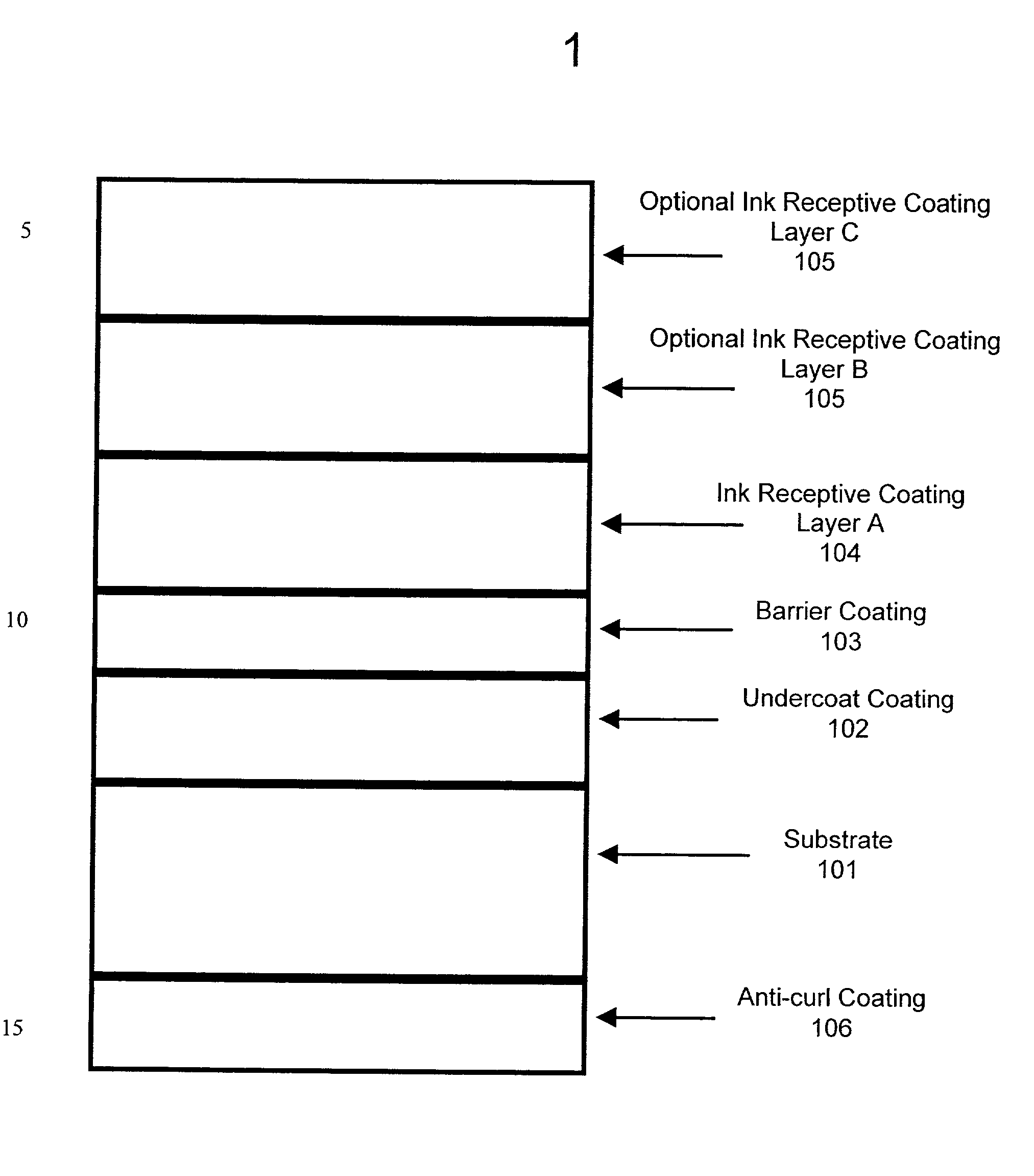Novel universal ink jet recording medium
a technology of ink jet and recording medium, which is applied in the direction of duplicating/marking methods, coatings, printing, etc., can solve the problems of undesirable end use problems, ink jet media that does not work well across a wide range of printer platforms, and new pigmented inks that do not adhere well to the ink receptive surfa
- Summary
- Abstract
- Description
- Claims
- Application Information
AI Technical Summary
Benefits of technology
Problems solved by technology
Method used
Image
Examples
example 2
[0030] A undercoat layer was prepared by coating 15 dry gsm of the following coating on a blade coater using the base sheet from example 1.
1 Dry Parts High Brightness #1 72 Ultra White 90 from Coating Clay Engelhard Synthetic Plastic 10 Rhopaque HP-543 from Pigment Rohm & Haas Polyvinyl acetate 5 Vinac 884 from Air Products latex Defoamer 0.09 Foamblast DF 122 from Henkle Thickener 0.18 Carboxymethylcellulose 9M8 from Hercules Dispersant 0.05 Dispex N-40 from Ciba Chemicals Flow & leveling 0.41 Nopcote C-104 from Geo Agent Specialty Chemicals Optical Brightener 2 Phorwite P from Bayer All parts given in this application are dry parts.
[0031] The coated sheet was run through a hot nip super calander to smooth the surface. This sheet gives a high gloss when super calandered and has excellent holdout for the barrier layer coating.
example 3
[0032] A barrier coat layer was prepared by coating 10 dry gsm of the following coating on a gravure coater using the basesheet from example 2. It was cured using ultra-violet light from a single Fusion H-bulb at a watt density of 300 watts / cm.sup.2 at a speed of 50 fpm.
2 Dry Parts Aromatic 15 CN 131 from Sartomer monoacrylate oligomer Tris (2- 105 SR 368 from Sartomer hydroxylethyl) isocyanurate triacrylate Ethoxylated 60 SR 454 from Sartomer trimethylolpropane triacrlyate Trimethyol propane 60 SR 351 from Sartomer triacrylate Polyethylene glycol 18 SR 259 from Sartomer diacrylate Alkoxylated 18 SR 9008 from Sartomer trifunctional acrylate ester Phenyl propanone 24 KIP 100F From Sartomer photoinitiator
[0033] The above coating had a surface energy of 38 dynes and a gloss of 80% at 60 degrees. The water barrier properties were rated excellent. The surface energy was increased to approximately 46 dynes through corona surface treatment.
example 4
[0034] A barrier coat layer was prepared by coating 10 dry gsm of the following coating on a gravure coater using the base sheet from example 2. It was cured using ultra-violet light from a single Fusion H-bulb at a watt density of 300 watts / cm.sup.2 at a speed of 50 fpm.
3 Dry Parts Aromatic 15 CN 131 from Sartomer monoacrylate oligomer Tri (2-hydroxylethyl) 105 SR 368 from Sartomer isocyanurate triacrylate Ethoxylated 60 SR 454 from Sartomer trimethylolpropane triacrlyate Polyethylene glycol 60 SR 610 from Sartomer diacrylate Polyethylene glycol 39 SR 344 from Sartomer diacrylate Phenyl propanone 24 KIP 100F From Sartomer photoinitiator
[0035] The above coating had a surface energy of 42 dynes and a gloss of 80% at 60 degrees. The surface energy was increased to approximately 46 dynes through corona surface treatment. The water barrier properties were rated excellent.
PUM
| Property | Measurement | Unit |
|---|---|---|
| speed | aaaaa | aaaaa |
| composition | aaaaa | aaaaa |
| hydrophobic | aaaaa | aaaaa |
Abstract
Description
Claims
Application Information
 Login to View More
Login to View More - R&D
- Intellectual Property
- Life Sciences
- Materials
- Tech Scout
- Unparalleled Data Quality
- Higher Quality Content
- 60% Fewer Hallucinations
Browse by: Latest US Patents, China's latest patents, Technical Efficacy Thesaurus, Application Domain, Technology Topic, Popular Technical Reports.
© 2025 PatSnap. All rights reserved.Legal|Privacy policy|Modern Slavery Act Transparency Statement|Sitemap|About US| Contact US: help@patsnap.com

